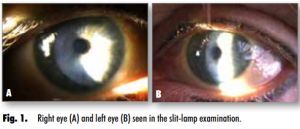Current issue
Archive
Online first
About the Journal
Editorial Board
Scientific Board
Reviewers
Abstracting and indexing
Publisher
Contact
Subscription
Ethical standards and procedures
Abstracting and indexing
For authors
Ethical standards and procedures
Publication charge
Books and Events
Books
Events
RESEARCH PAPER
Cornea Verticillata – a Rare Complication of Chloroquine Toxicity. Case Report
1
Student Scientific Society The Eye, Departament of Ophthalmology, Medical University of Warsaw
2
Department of Ophthalmology, Medical University of Warsaw
3
SPKSO Ophthalmic University Hospital in Warsaw
Submission date: 2023-10-22
Acceptance date: 2023-12-01
Publication date: 2023-12-29
Ophthalmology 2023;(4):12-14
KEYWORDS
ABSTRACT
Introduction: Cornea verticillata is characterized by bilateral grayish or golden-brown linear opacities in a typical vortex shape, mainly in the lower segments of the corneal epithelium, without covering the corneal stroma. It is most often associated with taking amiodarone but can be induced by other medications. Chloroquine is commonly used in treatment and prevention of protozoal diseases. Additionally, it has applications in dermatology and rheumatology as an anti-inflammatory agent in collagenosis, rheumatoid arthritis or lupus erythematosus. Its ophthalmic side effects and their management are noteworthy and are briefly summarized in this paper. Material and Methods: We present a case of a 62-year-old female patient who was referred to the clinic for diagnosis of corneal lesions detected incidentally during a follow-up examination 6 months after starting treatment with chloroquine for rheumatoid arthritis. Results: The patient was diagnosed with cornea verticillata and informed that it does not affect visual acuity and is not an indication for changes in therapy. Discontinuation of medication results in partial or, in some cases, complete resolution of changes. Discussion: It is important to closely monitor patients taking drugs that are known to have ophthalmic side effects for the first time in new indications. We should consider eye side effects when treating systemic disease and recommend screening tests. Conclusions: A baseline ophthalmic examination should be performed on all patients before initiating use of chloroquine. Moreover, chloroquine can lead to permanent loss of visual acuity contributing to bull’s eye maculopathy, which is irreversible.
We process personal data collected when visiting the website. The function of obtaining information about users and their behavior is carried out by voluntarily entered information in forms and saving cookies in end devices. Data, including cookies, are used to provide services, improve the user experience and to analyze the traffic in accordance with the Privacy policy. Data are also collected and processed by Google Analytics tool (more).
You can change cookies settings in your browser. Restricted use of cookies in the browser configuration may affect some functionalities of the website.
You can change cookies settings in your browser. Restricted use of cookies in the browser configuration may affect some functionalities of the website.




